ВУЗ: Казахская Национальная Академия Искусств им. Т. Жургенова
Категория: Книга
Дисциплина: Не указана
Добавлен: 03.02.2019
Просмотров: 21665
Скачиваний: 19
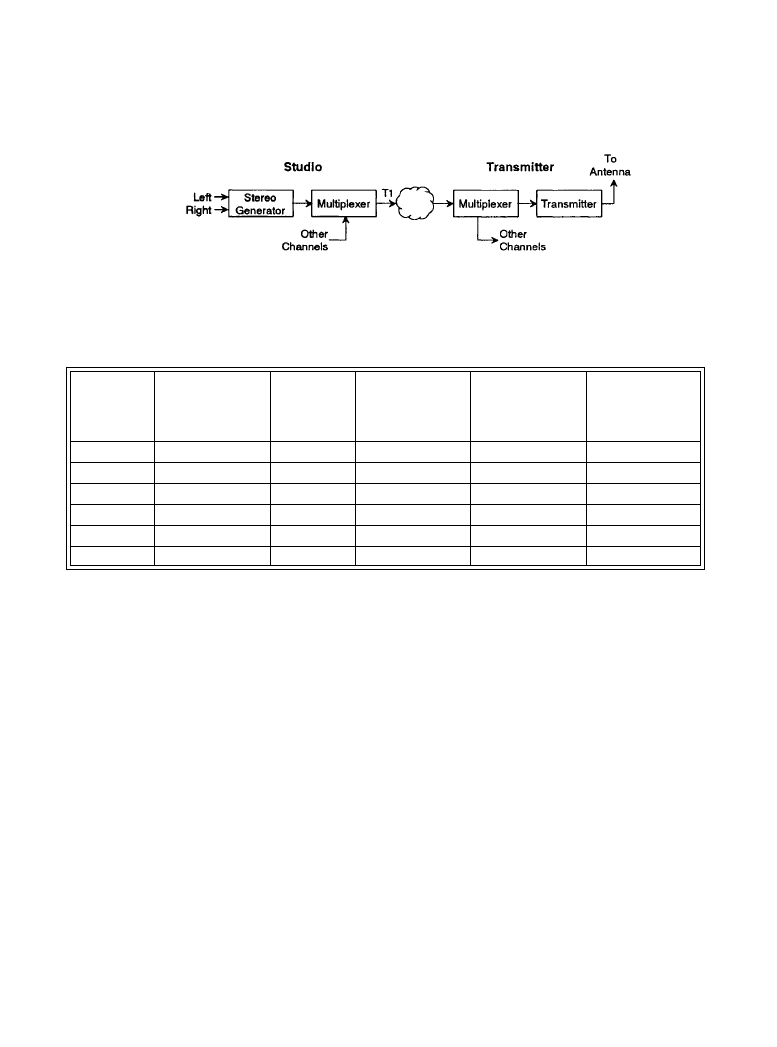
Radio STL Systems 11-67
11.4.2 STL System Configuration
The frequency range used by aural STL systems in the U.S. is 944.5 to 951.5 MHz. Frequencies
ranging from 200 to 940 MHz are used in other parts of the world. STL systems are also operated
above these traditional bands, however, such links often face difficulties associated with
increased susceptibility to signal loss as a result of precipitation, foliage, and fog, which limits
usage to short path lengths. Frequency modulation is used for analog STL systems.
The vast majority of radio STL systems in operation today carry a composite stereo baseband
signal from the studio to the transmitter. An alternative approach, and one that may be used for
monaural AM stations, involves the use of one or two narrowband STL systems. The two
approaches are compared in Figure 11.4.4.
The monaural STL typically has an audio bandwidth of up to 15 kHz for program signals, and
usually can accommodate a single FM subcarrier at approximately 39 kHz. For stereo or dual
mono installations, a common antenna can be used at the transmitter and at the receiver. At the
transmit site, a combiner/isolator adds the signals and prevents the generation of intermodulation
products. At the receive site, a low-noise antenna splitter feeds the individual receivers.
The composite STL has sufficient bandwidth (220 kHz) to accommodate the output of a ste-
reo FM generator and usually several separate subcarriers. A low-pass filter generally is used at
the output of the receiver to separate the signals to be broadcast over-the-air from the non-broad-
cast (or closed-circuit) signals. A typical configuration is illustrated in Figure 11.4.5. The com-
Figure 11.4.3
Composite T1 digital audio STL system. (
After [1].)
Table 11.4.1 Digital Audio Sampling Size vs. T1 Bandwidth Usage
(
After [1].)
System Type
Samples/s (for 15
kHz stereo)
Sample Size
Digital
Transmission Rate
Number of TI Time
Slots Used for
Broadcast Audio
Number of T1
Time Slots
Available for Other
Channels
Discrete
32,000
×
2
16-bit
1. 152 Mbits/s
18
6
Composite
112,000
16-bit
1.792 Mbits/s
Not usable
--
15-bit
1.680 Mbits/s
Not usable
--
14-bit
1.568 Mbits/s
Not usable
--
13-bit
1.456 Mbits/s
23
1
12-bit
1.344 Mbits/s
21
3
Downloaded from Digital Engineering Library @ McGraw-Hill (www.digitalengineeringlibrary.com)
Copyright © 2004 The McGraw-Hill Companies. All rights reserved.
Any use is subject to the Terms of Use as given at the website.
Radio STL Systems
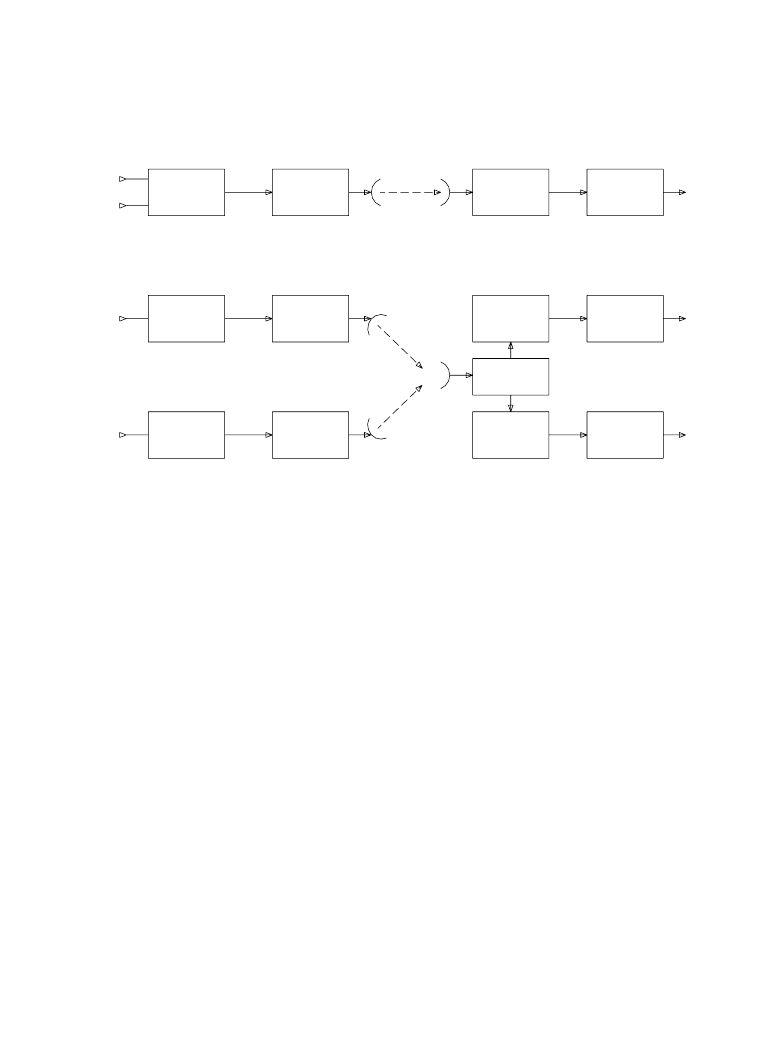
11-68 Broadcast Transmission Systems
posite STL provides superior stereo performance compared to dual monaural radio links in
several respects, including:
•
Elimination of interchannel phase and amplitude errors that can arise in a dual channel sys-
tem.
•
Elimination of audio headroom considerations because the STL input signal has already been
passed through the station's audio processing system and the stereo generator, which are
located at the studio.
For FM applications, the composite signal from the STL receiver is fed directly into the FM
transmitter exciter. An alternate method involves the use of Reciter [2], which functions as an
STL receiver and FM exciter but with an IF interface rather than a baseband interface. The elim-
ination of one stage of demodulation and remodulation reduces noise and distortion in the trans-
mitted FM signals.
Because AM stereo exciters require discrete right and left channel audio inputs, a comple-
mentary stereo decoder is used to recover the left and right channel audio if a composite STL
(fed by a stereo generator) is used.
STL
transmitter
STL
receiver
Exciter
RF power
divider
Stereo
generator
Program
audio
input
RF link
Studio site
Transmitter site
RF
output
RF link
Left
input
audio
control
Automatic
gain
transmitter
STL
Studio site
receiver
STL
Limiting
amplifier
Transmitter site
Left
output
audio
input
Right
audio
Automatic
control
gain
transmitter
STL
receiver
STL
amplifier
Limiting
output
audio
Right
L
R
(
b)
(
a)
Figure 11.4.4
Comparison of STL systems: (
a) composite transmitter-receiver system, (b) dual
monaural transmitter-receiver system. (
After [2].)
Downloaded from Digital Engineering Library @ McGraw-Hill (www.digitalengineeringlibrary.com)
Copyright © 2004 The McGraw-Hill Companies. All rights reserved.
Any use is subject to the Terms of Use as given at the website.
Radio STL Systems
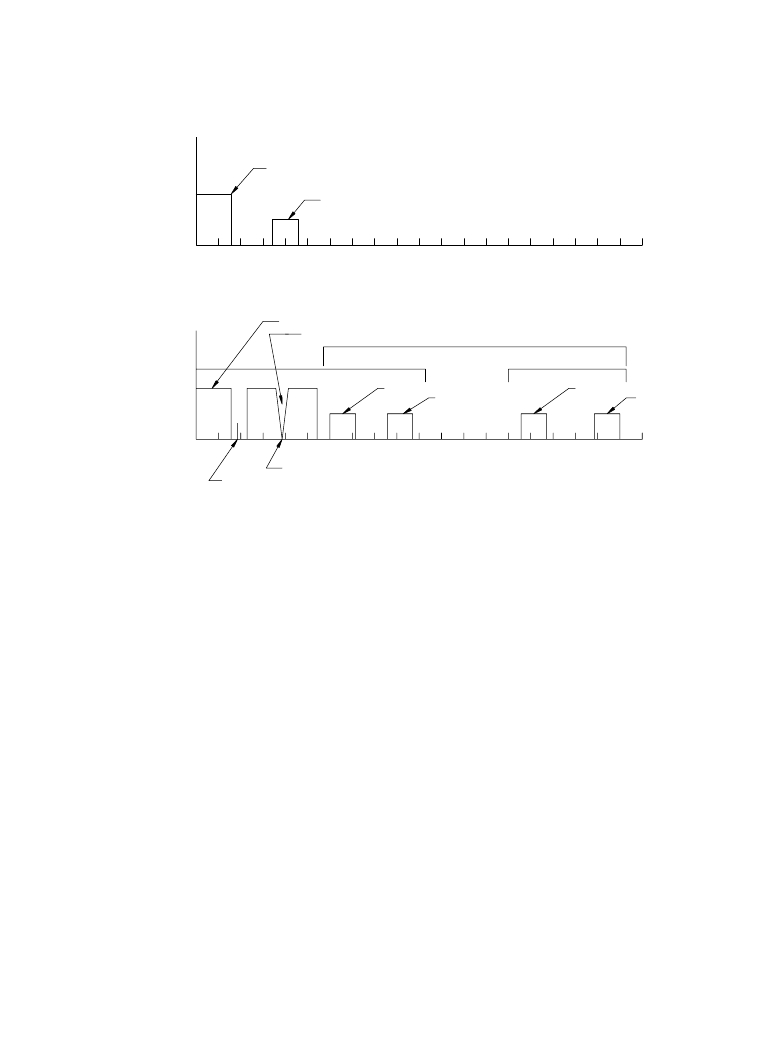
Radio STL Systems 11-69
11.4.2a
Digital STL vs. Analog STL Link
Digital signal encoding of audio frequency information provides a number of advantages over
conventional analog systems. The principal strengths of digital coding for transmission and stor-
age vs. analog methods include the following:
•
Greater immunity to noise and interference in the transmission path. Differences of 40 dB
SNR vs. 76 dB are common.
•
Elimination of transmission-path-dependent distortion mechanisms, such as harmonic distor-
tion, intermodulation distortion, and crosstalk.
•
Efficient use of baseband and RF spectrum.
•
Efficient and predictable regeneration of the digital signal.
•
Easy and effective encryption for security and coding purposes.
•
Uniformity in transmitting audio and data signals.
The last item merits additional consideration. Intense development has been underway for a
number of years to develop efficient and cost-effective digital coding and compression systems
for audio frequency signals. The results of this work can be seen in everything from personal
computer sound boards to recordable MP3-type minidisks. This technology, obviously, has many
spinoff effects that can be used to advantage by radio broadcasters. Advanced digital devices and
(
a)
(
b)
0
20
40
60
80
100
120
140
160
180
200
Baseband frequency
Re
la
tive
a
m
p
litu
d
e
Subcarrier (39 kHz center frequency)
Program channel (15 kHz high-frequency limit)
20
0
40
60
R
e
la
tive
a
m
p
litu
d
e
Baseband frequency
80
100
120
140
160
180
200
Subcarriers
Broadcast signals
Non-broadcast signals
19 kHz pilot
38 kHz center
L+R main channel
L-R subchannel
185 kHz center
152 kHz center
92 kHz center
67 kHz center
Figure 11.4.5
Baseband spectrum of STL systems: (
a) monaural, (b) composite. (After [2].)
Downloaded from Digital Engineering Library @ McGraw-Hill (www.digitalengineeringlibrary.com)
Copyright © 2004 The McGraw-Hill Companies. All rights reserved.
Any use is subject to the Terms of Use as given at the website.
Radio STL Systems
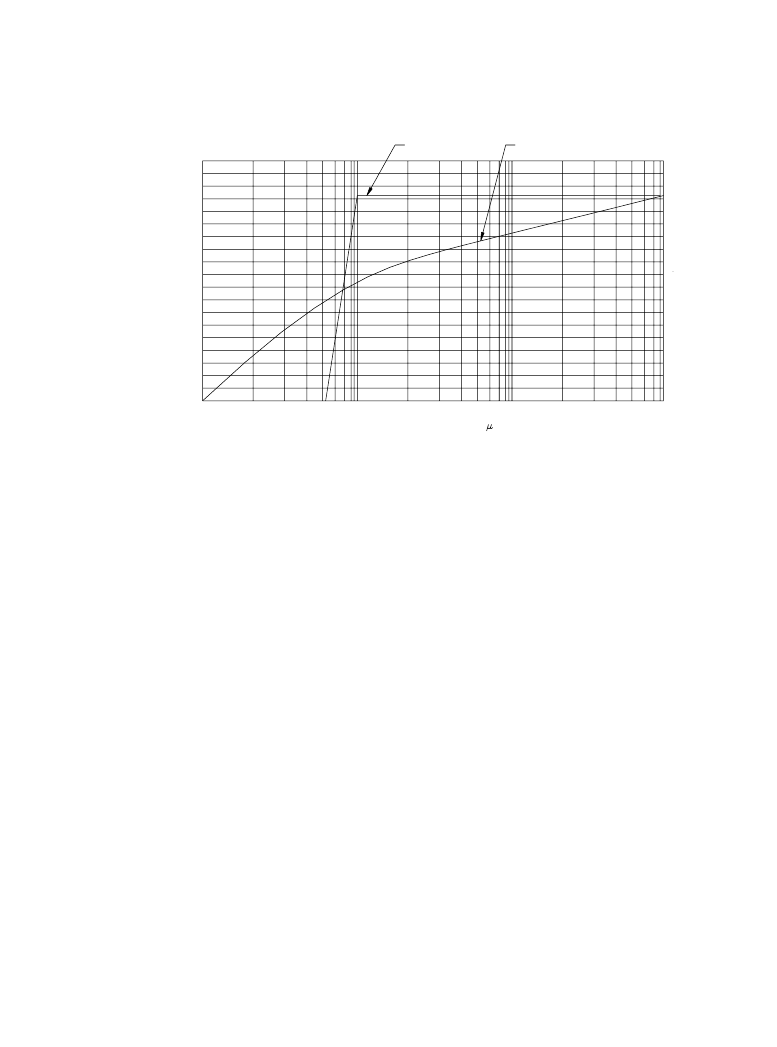
11-70 Broadcast Transmission Systems
algorithms are now being adapted for use in a wide variety of broadcast products, most notably
studio storage and mixing systems, and STL systems.
The use of digital coding and modulation in an STL system provides the user a number of
benefits in terms of performance and path reliability. By its nature, digital coding offers a more
robust link. As long as the received signal strength and carrier-to-noise exceed a defined mini-
mum value, the bit error rate remains relatively constant, and the decoded baseband signal is an
exact duplicate of the input signal at the studio. (See Figure 11.4.6.) With adequate error correc-
tion, signals can be received error-free. With a digital STL, multiple links are practical because
signal degradations are not additive, as in an analog system.
It is fair to point out that digitization of the input audio signal.always brings with it a measure
of degradation (quantization errors), but with the high sampling rates typically used for profes-
sional audio applications, such degradation is minor and almost always completely inaudible.
The process of quantization is illustrated in Figure 11.4.7. The sampling rate and quality of
the sampling circuit determine, in large part, the overall quality of the digital system. A properly
operating transmission channel can be assumed to provide error-free throughput. This being the
case, the digital signal can be regenerated at the receiving point as an exact duplicate of the input
waveform, quantization errors excepted. Figure 11.4.8 shows a general representation of a digital
communications channel. In the case of a radio link, such as an STL, the transmission medium is
analog in nature (FM). The circuits used to excite the FM modulator, however, are essentially
identical to those used for an all-digital link, such as fiber optic cable.
The functions of the encoder and decoder, shown in Figure 11.4.8a, usually are formed into a
single device, or set of devices (a chip set), known as a codec (coding and decoding device). At
the transmission end, the codec provides the necessary filtering to band-limit the analog signal to
avoid aliasing, thereby preventing analog-to-digital (A/D) conversion errors. At the receiver, the
S
ign
al
-t
o-
noi
s
e ra
ti
o
(dB
)
0
1.0
10
20
30
40
50
10
2.0
3.0
5.0
20
30
50
70
60
80
90
100
200
300
500
1E3
Received RF signal ( V)
Digital system
Analog system
Figure 11.4.6
The benefits of digital vs. analog STL systems in terms of S/N and received RF
level. (
After [2].)
Downloaded from Digital Engineering Library @ McGraw-Hill (www.digitalengineeringlibrary.com)
Copyright © 2004 The McGraw-Hill Companies. All rights reserved.
Any use is subject to the Terms of Use as given at the website.
Radio STL Systems
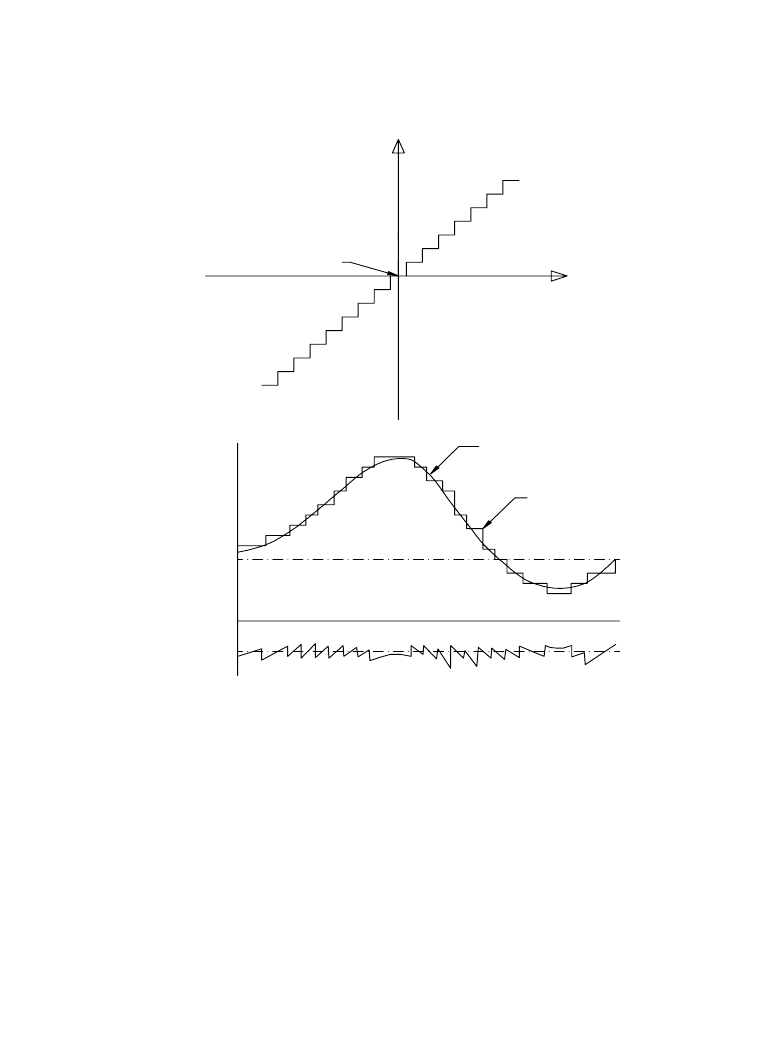
Radio STL Systems 11-71
codec performs the reciprocal digital-to-analog (D/A) conversion and interpolates (smooths) the
resulting analog waveform.
Digital STL Performance
The benefits of a digital STL for radio broadcasters can best be appreciated by comparing the
performance of a digital system and an analog system. A digital STL typically permits broad-
casters to extend the fade margin of an existing analog link by 20 dB or more. Furthermore,
audio signal-to-noise (S/N) improvements of at least 10 dB can be expected for a given RF signal
strength. Alternatively, for the same S/N, the maximum possible path distance of a given com-
0 1 11
0 1 01
0 0 11
00 0 1
1 0 00
1 0 10
1 10 0
11 1 0
0 1 10
01 00
00 1 0
11 11
11 0 1
1 01 1
1 0 01
A n alo g in pu t sign al (X )
Q u a n tize d o u tpu t (Y )
0 0 00
S
ign
al
am
p
lit
ud
e
Er
ro
r
Q u a ntize d ou tpu t
A n alog in pu t
T im e
(
a)
(
b)
Figure 11.4.7
Quantization of an input signal: (
a) quantization steps, (b) quantization error signal.
(
After [2].)
Downloaded from Digital Engineering Library @ McGraw-Hill (www.digitalengineeringlibrary.com)
Copyright © 2004 The McGraw-Hill Companies. All rights reserved.
Any use is subject to the Terms of Use as given at the website.
Radio STL Systems